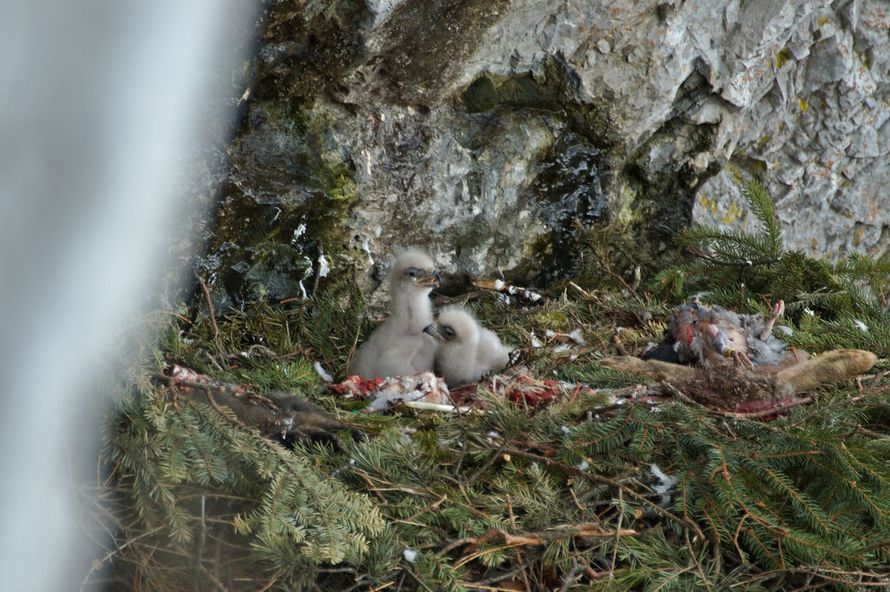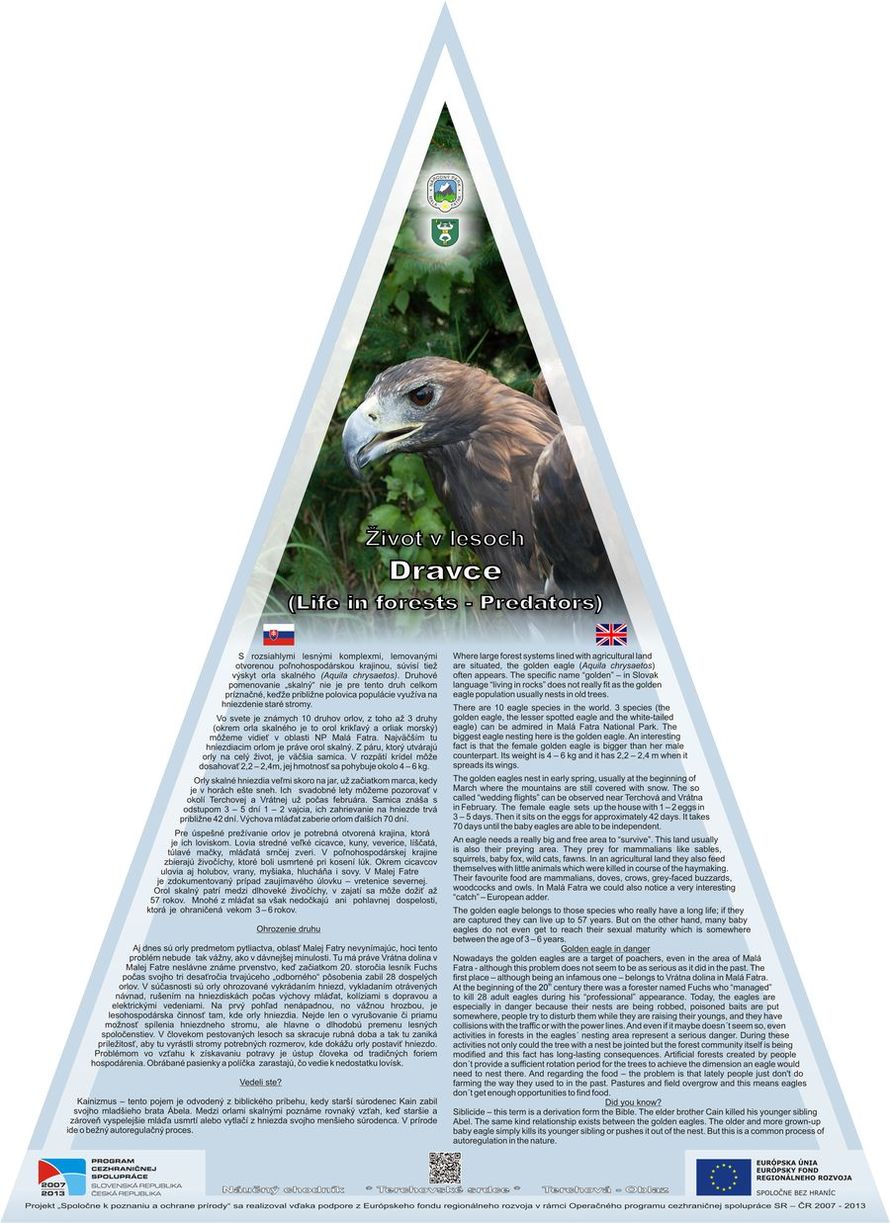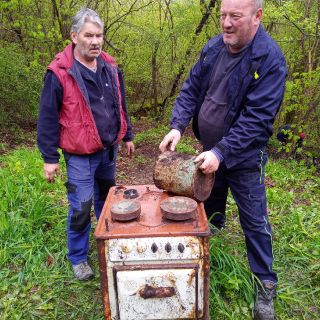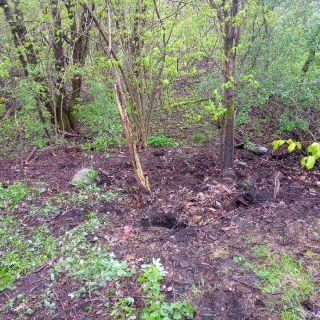Tabuľa 5 – Život v lesoch – dravce
S rozsiahlymi lesnými komplexmi, lemovanými otvorenou poľnohospodárskou krajinou súvisí tiež výskyt orla skalného (Aquila chrysaetos). Druhové pomenovanie „skalný“ nie je pre tento druh celkom príznačné, keďže približne polovica populácie využíva na hniezdenie staré stromy.
Vo svete je známych 10 druhov orlov, z toho až 3 druhy (okrem orla skalného je to orol krikľavý a orliak morský) môžeme vidieť v oblasti NP Malá Fatra. Najväčším tu hniezdiacim orlom je práve orol skalný. Z páru, ktorý utvárajú orly na celý život je väčšia samica. V rozpätí krídel môže dosahovať 2,2 – 2,4m, jej hmotnosť sa pohybuje okolo 4 – 6 kg.
Orly skalné hniezdia veľmi skoro na jar, už začiatkom marca, kedy je v horách ešte sneh. Ich svadobné lety môžeme pozorovať v okolí Terchovej a Vrátnej už počas februára. Samica znáša s odstupom 3 – 5 dní 1 – 2 vajcia, ich zahrievanie na hniezde trvá približne 42 dní. Výchova mláďat zaberie orlom ďalších 70 dní.
Pre úspešné prežívanie orlov je potrebná otvorená krajina, ktorá je ich loviskom. Lovia stredné veľké cicavce, kuny, veverice, líščatá, túlavé mačky, mláďatá srnčej zveri. V poľnohospodárskej krajine zbierajú živočíchy, ktoré boli usmrtené pri kosení lúk. Okrem cicavcov ulovia aj holubov, vrany, myšiaka, hlucháňa i sovy. V Malej Fatre je zdokumentovaný prípad zaujímavého úlovku – vretenice severnej.
Orol skalný patrí medzi dlhoveké živočíchy, v zajatí sa môže dožiť až 57 rokov. Mnohé z mláďat sa však nedočkajú ani pohlavnej dospelosti, ktorá je ohraničená vekom 3 – 6 rokov.
Ohrozenie druhu
Aj dnes sú orly predmetom pytliactva, oblasť Malej Fatry nevynímajúc, hoci tento problém nebude tak vážny, ako v dávnejšej minulosti. Tu má práve Vrátna dolina v Malej Fatre neslávne známe prvenstvo, keď začiatkom 20. storočia lesník Fuchs, počas svojho tri desaťročia trvajúceho „odborného“ pôsobenia zabil 28 dospelých orlov. V súčasnosti sú orly ohrozované vykrádaním hniezd, vykladaním otrávených návnad, rušením na hniezdiskách počas výchovy mláďat, kolíziami s dopravou a elektrickými vedeniami. Na prvý pohľad nenápadnou, no vážnou hrozbou je lesohospodárska činnosť tam, kde orly hniezdia. Nejde len o vyrušovanie či priamu možnosť spílenia hniezdneho stromu, ale hlavne o dlhodobú premenu lesných spoločenstiev. V človekom pestovaných lesoch sa skracuje rubná doba a tak tu zaniká príležitosť, aby tu vyrástli stromy potrebných rozmerov, kde dokážu orly postaviť hniezdo. Problémom vo vzťahu k získavaniu potravy je ústup človeka od tradičných foriem hospodárenia. Obrábané pasienky a políčka zarastajú, čo vedie k nedostatku lovísk.
Vedeli ste?
 Kainizmus – tento pojem je odvodený z biblického príbehu, kedy starší súrodenec Kain zabil svojho mladšieho brata Ábela. Medzi orlami skalnými poznáme rovnaký vzťah, keď staršie a zároveň vyspelejšie mláďa usmrtí alebo vytlačí z hniezda svojho menšieho súrodenca. V prírode ide o bežný autoregulačný proces.
Kainizmus – tento pojem je odvodený z biblického príbehu, kedy starší súrodenec Kain zabil svojho mladšieho brata Ábela. Medzi orlami skalnými poznáme rovnaký vzťah, keď staršie a zároveň vyspelejšie mláďa usmrtí alebo vytlačí z hniezda svojho menšieho súrodenca. V prírode ide o bežný autoregulačný proces.
Panel 5 – Life in forests – Predators
Where large forest systems lined with agricultural land are situated, the golden eagle (Aquila chrysaetos) often appears. The specific name “golden” – in Slovak language “living in rocks” does not really fit as the golden eagle population usually nests in old trees.
There are 10 eagle species in the world. 3 species (the golden eagle, the lesser spotted eagle and the white-tailed eagle) can be admired in Malá Fatra National Park. The biggest eagle nesting here is the golden eagle. An interesting fact is that the female golden eagle is bigger than her male counterpart. Its weight is 4 – 6 kg and it has 2,2 – 2,4 m when it spreads its wings.
The golden eagles nest in early spring, usually at the beginning of March where the mountains are still covered with snow. The so called “wedding flights” can be observed near Terchová and Vrátna in February. The female eagle sets up the house with 1 – 2 eggs in 3 – 5 days. Then it sits on the eggs for approximately 42 days. It takes 70 days until the baby eagles are able to be independent.
An eagle needs a really big and free area to “survive”. This land usually is also their preying area. They prey for mammalians like sables, squirrels, baby fox, wild cats, fawns. In an agricultural land they also feed themselves with little animals which were killed in course of the haymaking. Their favourite food are mammalians, doves, crows, grey-faced buzzards, woodcocks and owls. In Malá Fatra we could also notice a very interesting “catch” – European adder.
The golden eagle belongs to those species who really have a long life; if they are captured they can live up to 57 years. But on the other hand, many baby eagles do not even get to reach their sexual maturity which is somewhere between the age of 3 – 6 years.
Golden eagle in danger
Nowadays the golden eagles are a target of poachers, even in the area of Malá Fatra - although this problem does not seem to be as serious as it did in the past. The first place – although being an infamous one – belongs to Vrátna dolina in Malá Fatra. At the beginning of the 20th century there was a forester named Fuchs who “managed” to kill 28 adult eagles during his “professional” appearance. Today, the eagles are especially in danger because their nests are being robbed, poisoned baits are put somewhere, people try to disturb them while they are raising their youngs, and they have collisions with the traffic or with the power lines. And even if it maybe doesn´t seem so, even activities in forests in the eagles´ nesting area represent a serious danger. During these activities not only could the tree with a nest be jointed but the forest community itself is being modified and this fact has long-lasting consequences. Artificial forests created by people don´t provide a sufficient rotation period for the trees to achieve the dimension an eagle would need to nest there. And regarding the food – the problem is that lately people just don't do farming the way they used to in the past. Pastures and field overgrow and this means eagles don´t get enough opportunities to find food.
Did you know?
Siblicide – this term is a derivation form the Bible. The elder brother Cain killed his younger sibling Abel. The same kind relationship exists between the golden eagles. The older and more grown-up baby eagle simply kills its younger sibling or pushes it out of the nest. But this is a common process of autoregulation in the nature.

















